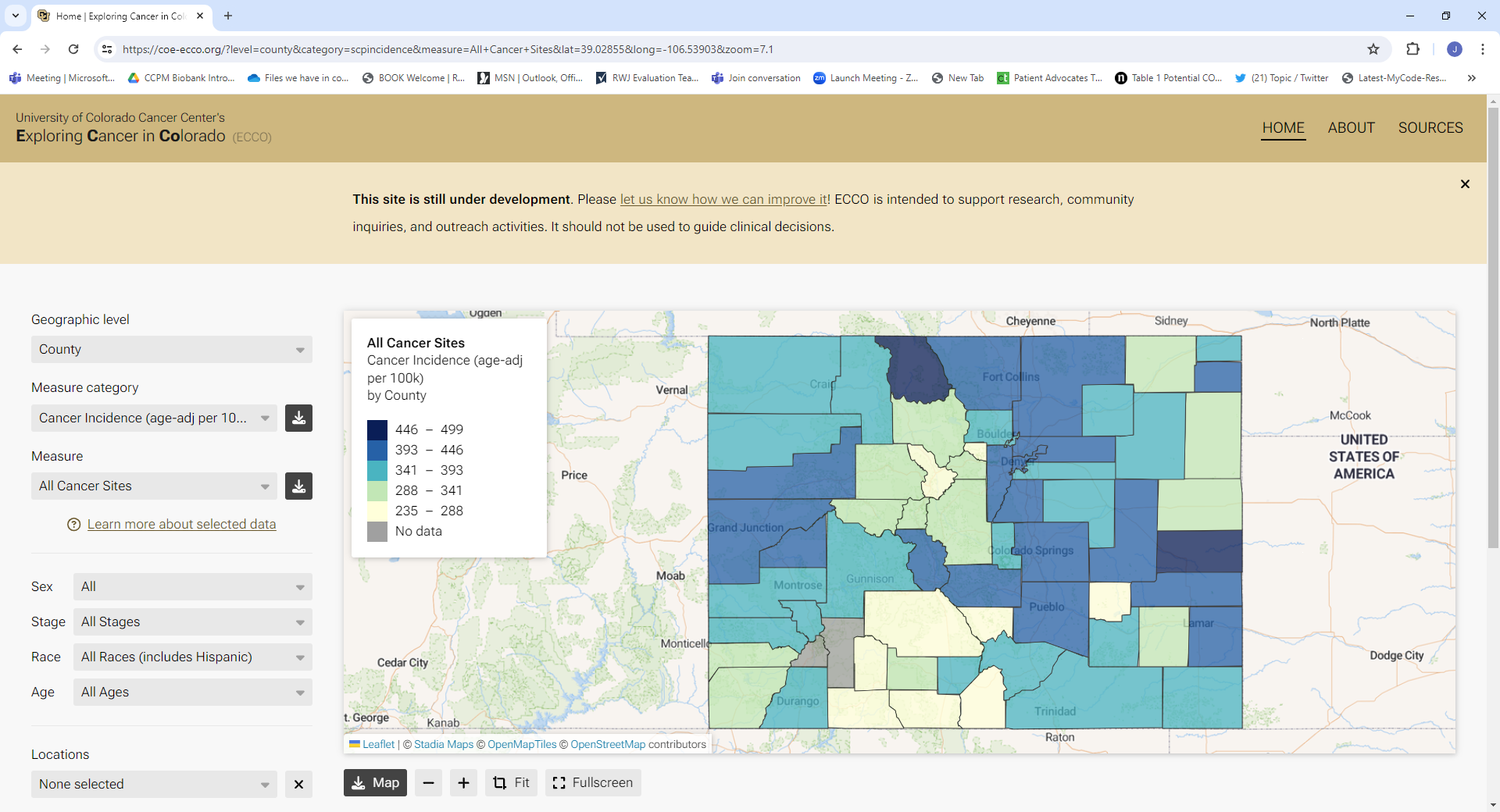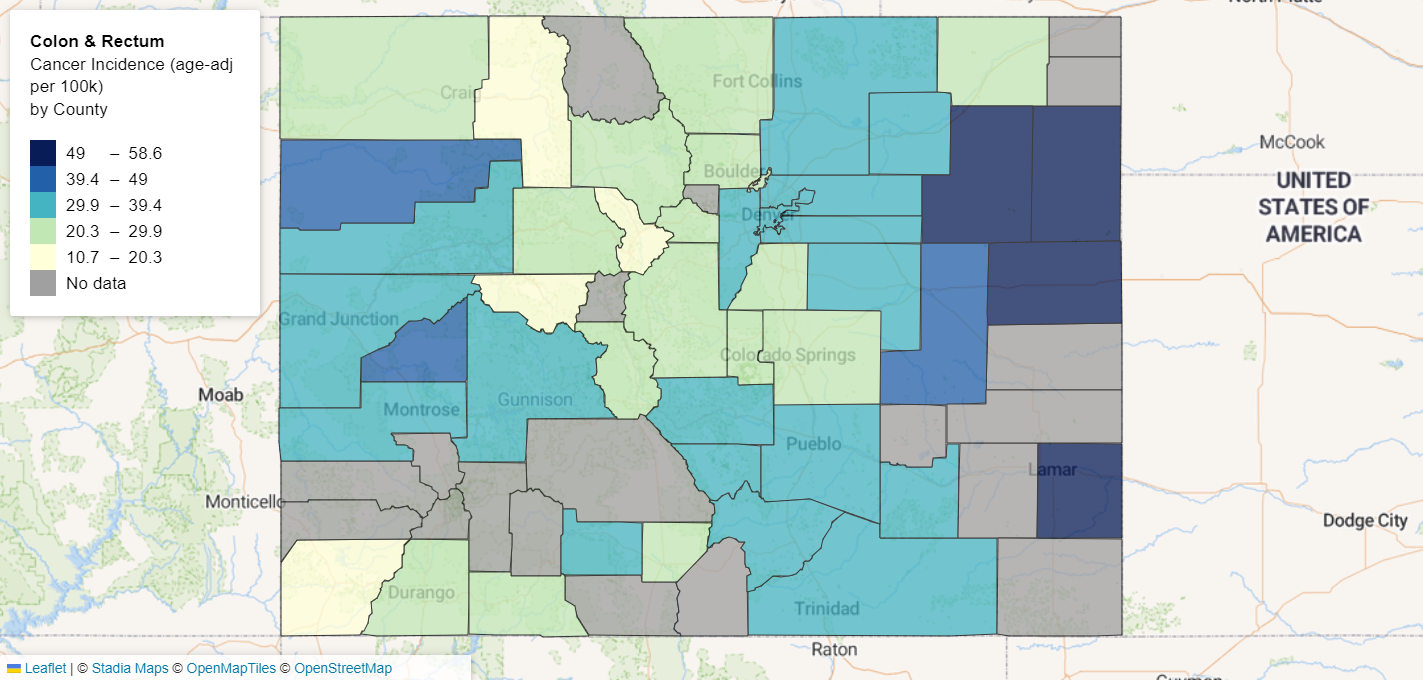Exploring Cancer in Colorado (ECCO)
Exploring Cancer in Colorado (ECCO) is an interactive platform that offers data covering Colorado demographics, cancer rates, disparities, risk factors, environmental exposures, and social determinants of health. Users can also
view locations for cancer prevention, treatment, and survivorship resources.
ECCO is intended to guide COE activities, inform/educate community partners, and support research - in particular, research that is relevant to our catchment area. It can be used to describe our catchment population in terms of demographics and cancer burden, generate new research hypotheses, and support grant applications/papers with data that can be downloaded and populated into tables and graphs.
Visualize your data and area of interest by creating custom maps
Start by choosing the geographic level (county or census tract) and the type of data measure you’re interested in such as sociodemographics, cancer burden, health behaviors or risk factors). Overlay locations for cancer care and other resources like screening centers or clinics onto map and click on regions or points for more details. Maps that you create can be downloaded by clicking on the ‘Map’ button below that map shown on the screen. Data by county and tract level for some measure categories can also be downloaded into an excel file by clicking on the download symbol next to the measure category.
Description of ECCO Components (on left of screen)
ECCO is intended to guide COE activities, inform/educate community partners, and support research - in particular, research that is relevant to our catchment area. It can be used to describe our catchment population in terms of demographics and cancer burden, generate new research hypotheses, and support grant applications/papers with data that can be downloaded and populated into tables and graphs.
Visualize your data and area of interest by creating custom maps
Start by choosing the geographic level (county or census tract) and the type of data measure you’re interested in such as sociodemographics, cancer burden, health behaviors or risk factors). Overlay locations for cancer care and other resources like screening centers or clinics onto map and click on regions or points for more details. Maps that you create can be downloaded by clicking on the ‘Map’ button below that map shown on the screen. Data by county and tract level for some measure categories can also be downloaded into an excel file by clicking on the download symbol next to the measure category.
Description of ECCO Components (on left of screen)
- Geographic level: Level at which data can be viewed. Census tract level is available for some measures.
- Measure Category: Types of data available. (some measures are only available for certain geographic levels)
- Measure: Sub-categories of Measure Category selected.
- Locations: Resources for cancer care, primary care and specialty care across state. These can be viewed on top of Measure Category selected (such as screening centers, clinics, specialists, etc.).
Access ECCO here

Catchment Description and Cancer Burden
The catchment area of the CU Cancer Center encompasses the entire state of Colorado. The catchment area represents >80% of the population that the CU Cancer Center serves through research,
clinical, and outreach and engagement initiatives. Colorado is now home to approximately 5.8 million people and our population has grown over 15% in the past 10 years. Colorado is the 8th largest state by land mass, covering 104,000 square
miles. There are 64 counties in Colorado, of these 47 (73%) counties are designated rural or frontier, where just over 12% of the population resides in those counties.
It is projected that 29,430 Coloradans will be diagnosed with cancer,
and 8,480 people will die from cancer in 2024. The five most common cancers diagnosed in Colorado include female breast, prostate, lung, colorectal, and melanoma. These cancers account for over 50% of all new cancers. Lung cancer remains the most
common cause of cancer death in Colorado followed by pancreatic, colorectal, prostate, and breast cancer.1
Cancer Disparities
Cancer incidence and mortality vary by race, ethnicity, and rurality. Overall,
Black/African Americans have higher incidence and mortality rates than all other racial groups in Colorado, and have higher mortality rates for prostate and lung cancer compared to African Americans across the U.S. With a few exceptions, Hispanics
have lower incidence and mortality compared to other groups. However, Hispanics in Colorado experience significantly higher incidence rates than Hispanics nationally for several cancer types including breast, lung and colorectal cancer.2 Cancer incidence and mortality tend to be higher among urban vs. rural dwellers, though the percent of screenable cancers diagnosed at late stages is higher in rural areas. 3
1. https://cancerstatisticscenter.cancer.org/states/colorado
2. https://statecancerprofiles.cancer.gov/index.html
3. Colorado Central Cancer Registry
